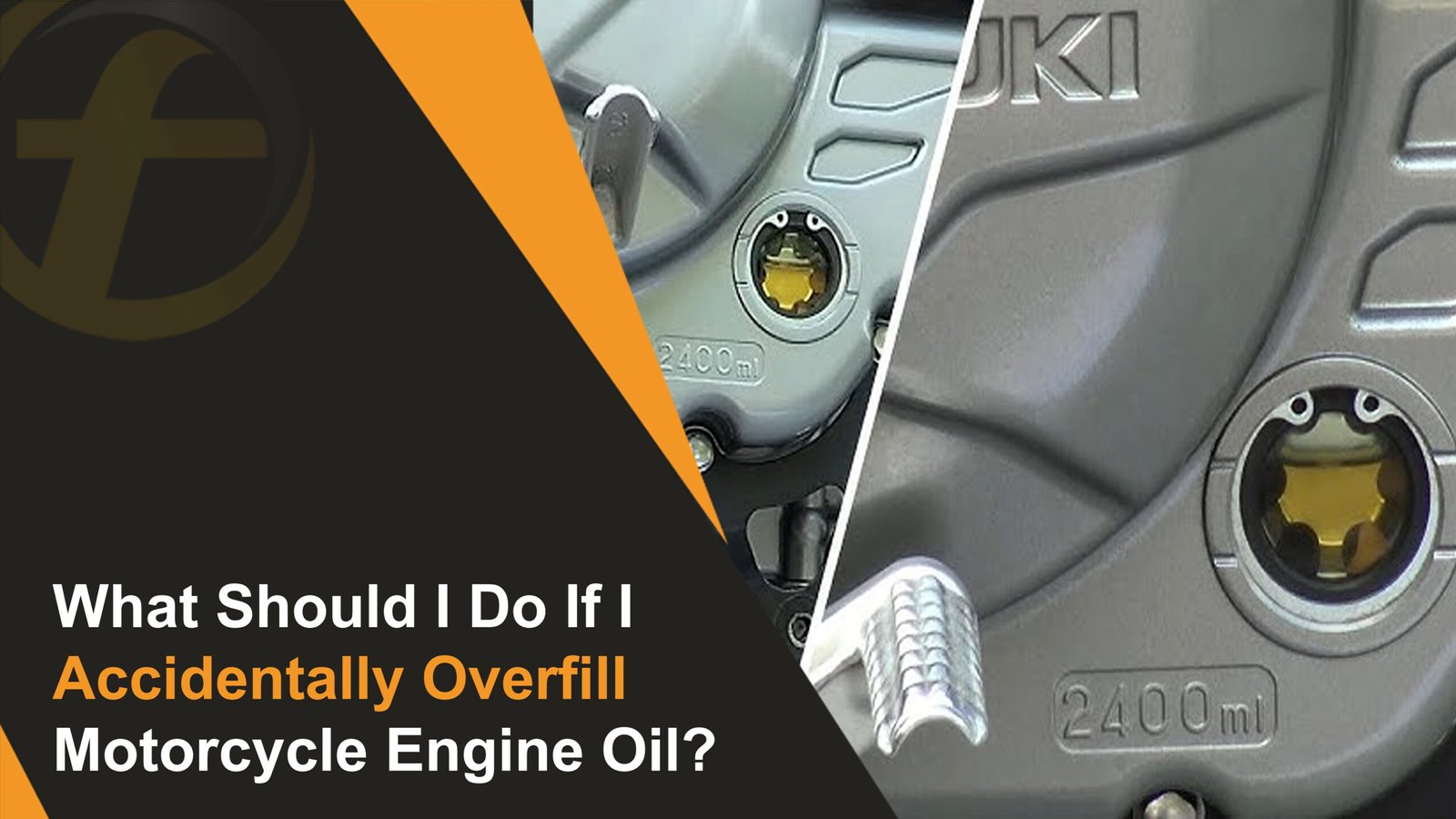
Changing your motorcycle’s oil on time is super important to keep it running smoothly. But sometimes, you might accidentally add too much oil. If that happens, don’t worry! It’s important to fix it quickly because too much oil can cause problems like leaks, smoke, or even damage to the engine. Let’s talk about what you can do if you accidentally overfill your engine oil.
Why Changing Oil Regularly Is Important and How to Avoid Adding Too Much
Changing your motorcycle’s oil is really important to keep it running well. Your bike’s owner’s manual tells you exactly how much oil it needs. If you put in too much oil, though, you might notice these problems: Your car’s oil tank is made to hold just the right amount of oil, with extra space for it to expand when the engine gets hot. Adding too much oil can cause problems. Look for these signs:
Signs You Put Too Much Oil in Your Motorcycle
Oil Leaks
If there’s too much oil, it can start leaking out of the engine. This can make the engine overheat because the oil can’t flow the right way. Without enough oil to protect the engine, it can get damaged.
Smoky Exhaust
Too much oil can make the engine run too hot. The oil breaks down and leaves gunk on important parts like the valves and pistons. This makes the engine work less well, and you might see white smoke coming from the exhaust.
Dirty Spark Plug
If the oil is too high, it can make the spark plug dirty. This means the spark plug can’t do its job properly, and the engine might misfire or run badly.
What to Do
If you see any of these problems, check the oil level. Make sure it’s not too high. Keeping the oil at the right level helps your motorcycle run better and last longer!
Adding too much oil to your engine can cause big problems. Here’s what might happen:
- Too Much Pressure on the Crankshaft: The crankshaft works best with the right oil pressure. Too much oil adds extra pressure, which can cause leaks. If the oil leaks onto the flywheel, it can get into the transmission and damage it.
- Friction on the Crankshaft: When there’s too much oil, it can’t lubricate the crankshaft properly. This causes friction, which can damage the crankshaft over time.
- Engine Problems: Too much oil can mess up the engine’s pressure, stopping parts from getting the lubrication they need. This can cause wear and tear. Extra oil might also flow into the exhaust pipe and combustion chamber, clogging them and making your engine stop working.
- Oily Spark Plug: If there’s too much oil, it can flood the spark plug. When this happens, the spark plug won’t work and needs to be replaced.
How to Check Your Oil Level
If your vehicle isn’t running right, check the oil level with the dipstick. Follow these steps:
- Warm Up the Engine: Turn on the vehicle for a few minutes.
- Park on Flat Ground: Make sure the vehicle is level and turn off the engine.
- Find the Dipstick: Open the hood and look for the dipstick.
- Check the Oil: Pull the dipstick out, wipe it clean, and put it back in. Then, pull it out again and look at the oil level.
The oil should be between the “L” (Low) and “F” (Full) marks or the Min and Max lines. If it’s too low, add oil slowly until it reaches the Full mark. Be careful not to add too much!
Helpful Reminder
Check your oil every week or after long trips to keep your engine running smoothly.
How to Fix too Much Oil in Your Engine
If you put too much oil in your engine, don’t drive your bike! Too much oil can damage your engine. The best thing to do is remove the extra oil until the level is right.
Here’s how you can fix it:
- Find the drain plug at the bottom of the engine.
- Slowly let out the extra oil, just like when you do an oil change.
- Check the dipstick to make sure the oil level is between the “Low” and “Full” marks.
For more help, check out our easy guide on how to change your oil.
How Much Oil Does Your Vehicle Need?
The amount of oil your vehicle needs depends on the size of its engine. Most vehicles need between 3 and 8 liters of oil.
Here’s a simple guide:
- 3-cylinder engines: About 3 liters of oil
- 4-cylinder engines: Around 4.5 liters of oil
- 6-cylinder engines: About 5.5 liters of oil
- 8-cylinder engines: Between 4.5 and 7.5 liters of oil
Check your vehicle’s manual to find the exact amount of oil it needs. The manual will also tell you the type of oil that works best for your vehicle.
How to Check Your Bike’s Engine Oil
Checking your bike’s oil is super important to keep the engine working well. Follow these easy steps to do it right:
Park on a Flat Surface
Make sure your bike is on a flat surface so you can get the right oil reading. Use the center stand if your bike has one, or ask someone to hold the bike upright for you.
Look at the Oil Level
Check the oil level using the sight glass (a little window on the engine) or a dipstick. It’s best to do this when the engine is cold or after it has cooled down. The oil should be between the “Min” and “Max” marks—never above the “Max” line.
Add Oil Slowly
If the oil is too low, add a little bit at a time. Keep checking the level to make sure you don’t add too much. Check your bike’s manual to see how much oil it needs. If you’ve changed the oil filter, you might need to add a bit more oil.
By checking your oil regularly and keeping it at the right level, you’ll help your bike stay in great shape for a long time!
Why Overfilling is Bad
If you add just a tiny bit more oil than the maximum mark, it’s usually okay. Bikes are built to handle a little extra oil when it gets hot and expands. But adding a lot more oil can cause serious problems for your engine.
Here’s what can happen:
- Too Much Pressure in the Engine: Extra oil creates high pressure in the engine’s crankcase. This pressure can damage the seals that keep oil from leaking. Most bikes have vents to help, but too much oil is still not safe.
- Foamy Oil: When there’s too much oil, the crankshaft spins and splashes it around, mixing it with air. This makes the oil foamy. Foamy oil can’t lubricate the engine properly, which is bad for the moving parts.
- Poor Lubrication: Foamy oil doesn’t flow well, so the engine parts don’t get the protection they need. This makes the engine work harder and wear out faster.
- Engine Lock-Up: If the oil isn’t working as it should, the engine can overheat or stop working completely.
How to Avoid Problems
Always check your bike’s oil level carefully. Make sure it’s between the “Low” and “Full” marks on the dipstick. Too much oil might seem like a small mistake, but it can damage your engine in the long run. Keep an eye on it to keep your bike running smoothly!
Bottom Line
Changing your bike’s oil regularly helps keep the engine running well and lasts longer. If you add too much oil by mistake, it can cause problems, so it’s important to check your oil level carefully. Always follow the instructions in your bike’s manual and make sure the oil is at the right level. By doing this, you’ll keep your bike’s engine in great shape!
For the best protection and performance, choose Fubex Motorcycle Engine Oil—designed to keep your bike running smoothly and efficiently. Make sure to add the right amount and keep your bike’s engine in top condition!
FAQs
Q1: Will extra oil burn off?
Ans: If you put too much oil in your engine, you might see thick white smoke coming from the exhaust. This happens because the extra oil is burning inside the engine. But remember, other fluids like antifreeze can also cause white smoke, so it’s a good idea to check your oil level to make sure it’s not too high.
Q2: How long can I drive with too much oil?
Ans: If you have too much oil in your vehicle, it’s best to fix it right away. How long you can drive with too much oil depends on how much extra oil is in there and how you’re driving. But it’s always a good idea to take care of it soon so you don’t damage your engine.

Editor-at-Large
A passionate writer in the lubricant industry, Awais Iqbal has been covering oils, greases, and industrial fluids since the start of his career. At 25, he’s already written for blogs, catalogs, and brand guides across the UAE. Awais’s insights help companies connect with their audience, and his clear, helpful writing style is trusted by brands in the region.


